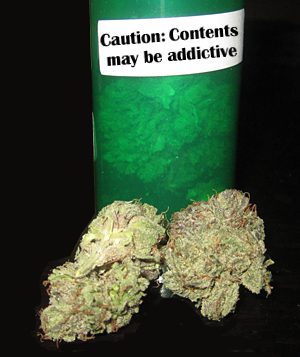With over 30 states legalizing the medicinal use of marijuana, and Colorado and Washington’s landmark passages of recreational usage, pot is all over the news. More than 80 million Americans over the age of 12 have tried marijuana at least once making it the most used illegal drug in the country.
 Tetrahydrcannabinol (THC) is the psychoactive ingredient in marijuana. It enters the bloodstream and attaches itself to cannabinoid receptors in the brain, located in the section of the brain that influences pleasure, sensory and time perception, thinking and concentration.
Tetrahydrcannabinol (THC) is the psychoactive ingredient in marijuana. It enters the bloodstream and attaches itself to cannabinoid receptors in the brain, located in the section of the brain that influences pleasure, sensory and time perception, thinking and concentration.
Today’s modern strains of marijuana are much more potent than those in ‘60s when pot usage started gaining pop culture notoriety and acceptance. In the 1980s, THC concentration averaged 4 percent, compared to 15 percent today, according to the National Institute on Drug Abuse. Premium strains can push the percentage into the high 20s, making marijuana addiction a reality.
With so much pot available, it’s not surprising that an estimated 9 percent of users are addicted to marijuana, and could potentially be diagnosed with Cannabis Use Disorder, as outlined in the latest edition of the Diagnostic and Statistical Manual of Mental Disorders (DSM-5).
Published in May 2013 by the American Psychiatric Association (APA), the DSM-5 updated this use disorder. In the previous edition of the manual, this condition was broken into two different categories, cannabis abuse and cannabis dependence.
Cannabis use disorder, as it is now called, is defined as a problematic pattern of cannabis use leading to clinically significant impairment or distress.
According to the DSM-5, what are some symptoms of cannabis intoxication?
- Significant rise in the normal heart rate
- Dry mouth
- Elevated appetite
- Red eyes and unusual fluid accumulation in the eyelids
- Psychological and behavioral impairments
In a user’s terms, as a person gets “high” they experience paranoia, cotton mouth, and bloodshot eyes, followed by the munchies.
While many people deny that marijuana is addictive, studies have shown that withdrawal from the habitual use of this substance is similar to other drugs that are widely accepted as addictive.
The DSM-5 criteria for cannabis withdrawal requires that a user experience three or more of the following symptoms within one week of quitting and that they are severe enough to impair social and occupational duties:

- Irritability, anger or aggression
- Anxiety or nervousness
- Difficulty sleeping, insomnia or disturbing dreams
- Weight loss or decreased appetite
- Depressed mood
- Restlessness
- Headaches, fever, chills, sweating
- Abdominal pain
There’s no doubt that heavy marijuana use is not only addictive, but it can cause problems in the daily life of users. Regular pot smokers generally have poorer physical and mental health, and report a lower life satisfaction due to relationship difficulties and less career success. Many also report low motivation and memory problems.
Treatment for cannabis use disorder, or a pot addiction, can be successful, and there are a variety of non 12 step alternatives available to help. A first step would be for marijuana users to understand the five stages of change for tracking recovery, which will lead them to sobriety and free from a life dependent on marijuana.
Federal and state courts will no doubt continue the battle over whether or not to legalize marijuana. In the meantime, addiction, as with alcohol and prescription drugs, will remain another matter altogether.
Related:
These Aren’t Your Grandma’s Brownies: Marijuana Edibles
Colorado’s Marijuana Education Campaign
7 Designer Drugs Parents Should Know About





